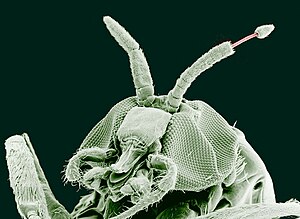Onchocerciasis
| Onchocerciasis | |
|---|---|
| Synonyms | river blindness, Robles disease |
 |
|
| An adult black fly with the parasite Onchocerca volvulus coming out of the insect's antenna, magnified 100x | |
| Pronunciation | /ˌɒŋkoʊsɜːrˈsaɪəsᵻs, -ˈkaɪ-/ |
| Classification and external resources | |
| Specialty | infectious disease |
| ICD-10 | B73 |
| ICD-9-CM | 125.3 |
| DiseasesDB | 9218 |
| eMedicine | med/1667 oph/709 |
| MeSH | D009855 |
Onchocerciasis, also known as river blindness, is a disease caused by infection with the parasitic worm Onchocerca volvulus. Symptoms include severe itching, bumps under the skin, and blindness. It is the second most common cause of blindness due to infection, after trachoma.
The parasite worm is spread by the bites of a black fly of the Simulium type. Usually, many bites are required before infection occurs. These flies live near rivers, hence the name of the disease. Once inside a person, the worms create larvae that make their way out to the skin. Here, they can infect the next black fly that bites the person. There are a number of ways to make the diagnosis including: placing a biopsy of the skin in normal saline and watching for the larva to come out, looking in the eye for larvae, and looking within the bumps under the skin for adult worms.
A vaccine against the disease does not exist. Prevention is by avoiding being bitten by flies. This may include the use of insect repellent and proper clothing. Other efforts include those to decrease the fly population by spraying insecticides. Efforts to eradicate the disease by treating entire groups of people twice a year is ongoing in a number of areas of the world. Treatment of those infected is with the medication ivermectin every six to twelve months. This treatment kills the larva but not the adult worms. The antibiotic doxycycline weakens the worms by killing an associated bacterium called Wolbachia, and is recommended by some as well. The lumps under the skin may also be removed by surgery.
About 17 to 25 million people are infected with river blindness, with approximately 0.8 million having some amount of loss of vision. Most infections occur in sub-Saharan Africa, although cases have also been reported in Yemen and isolated areas of Central and South America. In 1915, the physician Rodolfo Robles first linked the worm to eye disease. It is listed by the World Health Organization as a neglected tropical disease.
...
Wikipedia
